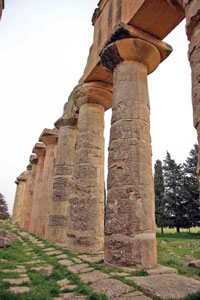
In a country that is mostly desert, Libya wants to preserve a rare verdant region with archaeological treasures from the ravages of looting and encroaching urbanisation.
To meet that ambitious goal the North African country has launched the world’s first large-scale conservation and sustainable development project in the mountainous region of Djebal Al-Akhdhar (Green Mountain), about 1,200 kilometres (750 miles) from the capital Tripoli.
The massive ecological and cultural project, encompassing a region nearly the size of Wales, will be headed by the son of Libyan leader Moamer Gaddafi.
“It is time to join developed countries and make a statement that we are also concerned about the environment and culture,” said Seif al-Islam Gaddafi at the project launch.
It took place at Libya’s ancient Greek city of Cyrene, dating back to 631 BC, a UNESCO World Heritage Site in the heart of the Green Mountain region.
Seif al-Islam, wearing traditional clothes, chose an imposing location to declare the country’s commitment to sustainable development.
Standing at the foot of the monumental columns of the ancient Temple of Zeus overlooking the Mediterranean Sea, he said that the protected zone would extend for some 5,500 square kilometres (2,000 square miles) along 200 kilometres of coastline, making it the largest project of its kind.
“This treasure is not just for Libyans but for all mankind,” he said.
The Libyan government has founded the Green Mountain Conservation and Development Authority, including engineers, archaeologists and experts on the environment and sustainable development, to steer the massive project and secure the necessary foreign investment.
The vision for this rare region of Libya includes eco-tourism, conservation of animals and plant life, clean industries and renewable energy. The regional plan is being developed by the firm of renowned British architect Norman Foster, whose global projects include Beijing Airport, the Millau Viaduct in France, and the restoration of the Reichstag in Berlin.
Such a major undertaking needs “foreign assistance and help,” said al-Islam, who heads the Gaddafi Foundation for Development and also Libya’s Red Crescent Society.
Only about 10 per cent of Libya's ancient treasures can be seen today as most of its cultural wealth still needs to be dug up. “We have promises and I hope a commitment from the European Union to help us with our project to restore and rebuild the ancient cities in Libya,” he said.
Joseph Stanislaw, an energy adviser, says the project is unique “because of the scale, size and holistic approach. The preservation of the beauty here is the way to develop industries and create a vibrant local economy and maintain the culture of the region.”
The cost of a project of this scale will be ‘billions and billions of dollars,’ added the president of The JAStanislaw Group. No official cost estimate was announced. Stanislaw said that financing will be split between foreign investors, the Libyan government and foundations.
The project’s timing is critical as the Green Mountain region was on the brink of an environmental and cultural catastrophe, said Jomaa Anag, head of the Libya's department of archaeology.
Forest fires and urbanisation have destroyed vast swathes of the region's forestland, which now amounts to about 180,000 hectares (445,000 acres) compared with 500,000 hectares 20 years ago.
(AFP)
